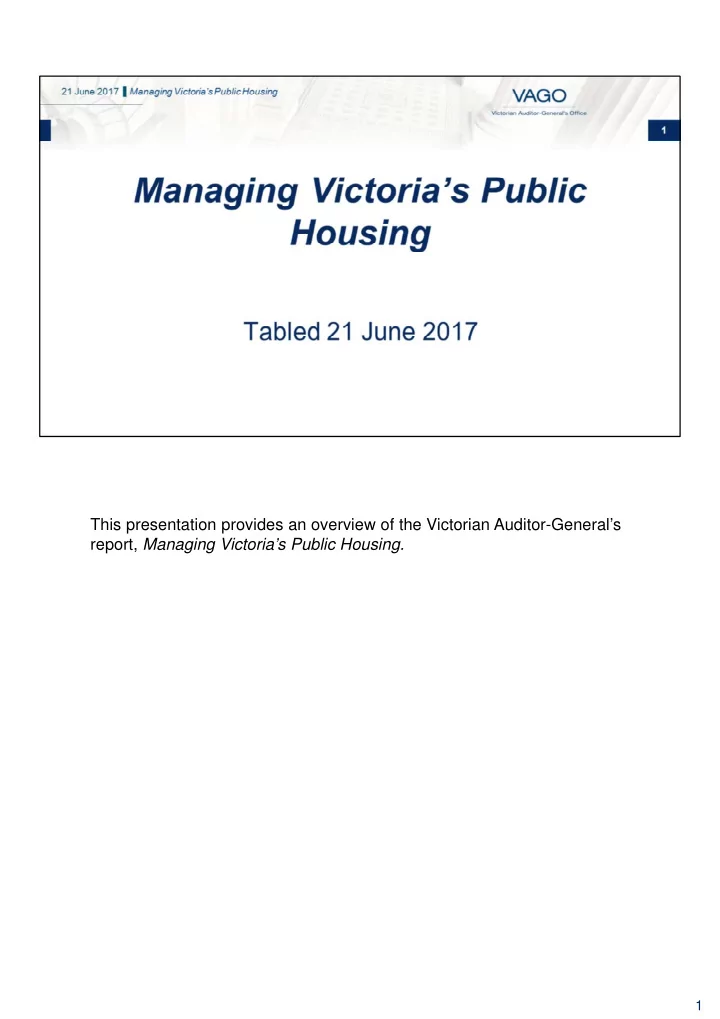

This presentation provides an overview of the Victorian Auditor-General’s report, Managing Victoria’s Public Housing. 1
Government and not-for-profit organisations provide social housing to people who are unable to access suitable accommodation in the private market. Access to social housing is important because it: • reduces the risk of homelessness • increases capacity to meet living costs, and • helps to address other issues like mental illness. Social housing refers to: • Public housing, which includes 64 663 dwellings owned and/or managed by government, and used to provide long-term subsidised rental accommodation to low-income, disadvantaged households. • And, community housing, which includes around 19 000 dwellings owned and/or managed by not-for-profit organisations. Community housing provides both long-term and short-term housing to people in need. 2
The Housing Act 1983 sets out the legislative framework for public housing. The Act establishes the roles and responsibilities of the Director of Housing, who sits within the Department of Health and Human Services (DHHS). 3
In this audit we assessed whether the development of the March 2017 housing strategy, Homes for Victorians , was supported by sound advice in relation to public housing. We also assessed whether DHHS is managing public housing effectively. In addressing this objective, we followed up on recommendations from our last public housing performance audit in 2012, Access to Public Housing . Audited agencies included DHHS, the Department of Premier and Cabinet (DPC) and the Department of Treasury and Finance (DTF). 4
Despite DHHS undertaking a range work since our 2012 audit, the public housing challenges we previously identified remain relevant today. These include: • a lack of long-term direction • financial sustainability that is managed using short-term approaches such as deferral of stock acquisitions and renewals • aging stock, with 60 per cent of dwellings now over 30 years old • significant unmet demand for public housing, and • a portfolio that is not configured to meet significant demand for one and two bedroom dwellings. 5
There is significant work underway to address these challenges. This includes the implementation of Homes for Victorians, which is addressing public housing challenges through a broader set of social housing measures. Its development was supported by extensive work that identified and considered key public housing challenges. However, gaps in this work mean it is unclear whether funded initiatives will translate into meaningful social housing growth, and address the significant gap between supply and demand. 6
An asset strategy is a key part of an asset management framework. It guides and optimises decisions at each stage of the asset life cycle— planning, acquisition, operation and disposal. We found that DHHS’s existing 2014 asset strategy for public housing and its supporting plans do not: • reflect a systematic or transparent life cycle approach to managing assets • establish a useful governance and performance monitoring regime for assets, and • reflect a systematic or comprehensive understanding of service demand over the medium to long term. Public housing asset management has also been undermined by: • unreliable property condition data • inconsistent regional input to asset planning decisions, and • a sub-optimal balance between expenditure on programmed and responsive maintenance. Encouragingly, DHHS is already working to address these issues. This includes development of an updated asset strategy. 7
We made four recommendations for DHHS, DTF and DPC to: • Set a long-term strategic direction for public housing • Monitor, evaluate and report on the delivery of Homes for Victorians • Assess the impacts of changes to the community housing sector arising from Homes for Victorians , and • Implement strategies to ensure the long-term sustainability of public housing. We made two recommendations for DHHS to: • Develop and implement an effective asset strategy • Address shortcomings with property condition assessments, and optimally balance expenditure on responsive and programmed maintenance. The departments have accepted all recommendations and outlined how each will be addressed. 8
For further information, please see the full report of this audit on our website, www.audit.vic.gov.au. 9
Recommend
More recommend